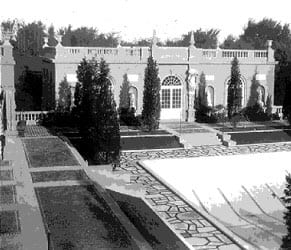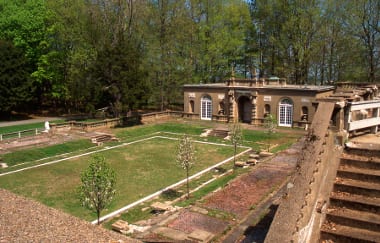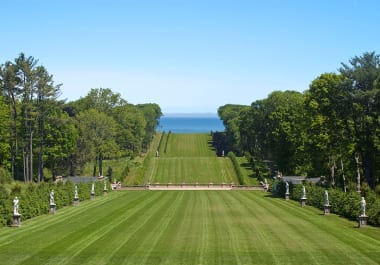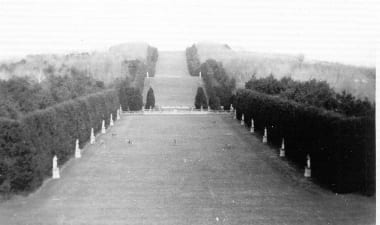by Lucinda (Cindy) Brockway
This fall, The Trustees of Reservations will complete a five-year landscape restoration project of the Crane Estate’s Allée and Casino Courtyard located in Ipswich, MA. Thanks to the generosity and hard work of talented staff, contractors, community partners, donors, and volunteers, The Trustees carefully removed and replanted over 700 deteriorating, overgrown trees along a half-mile-long formal vista; reinvigorated an underground, rainwater collection cistern; and restored the beautiful Italianate (former) swimming pool courtyard nestled in the middle of the Allée. Since 1949, when the Crane family gifted Castle Hill to The Trustees, the Allée has become a popular and impressive backdrop for open-air concerts, weddings, historic house and landscape tours, community events, a children’s summer camp, and other recreational activities held year-round at the Crane Estate.
The Crane family came to Castle Hill in 1909 and began a series of land purchased that eventually became a 165 acre estate amidst a 2,100 acre wildlife refuge. Far from public services and situated at the top of three hills overlooking the Atlantic Ocean, the Ipswich River and the Essex River, the estate, by its very location, had to be created as a self-sustaining entity operating under its own power plant, growing its own food, harvesting its own water and functioning independent of Ipswich village. Hard to imagine this massive estate living ‘off the grid,’ but that is essentially what the Crane’s created. With the knowledge of a successful businessman and engineer whose fortunes were created from the family’s pipe and plumbing business, the estate’s infrastructure systems were ingenious and state of the art for the early twentieth century, offering many lessons for today’s sustainability conversations. The Allée and Casino are the property’s most iconic landscape features and their restoration projects taught many sustainability lessons.
The Allée is one of only a few remaining worldwide – a half-mile-long ocean vista lined with formal evergreen hedges backed by deciduous woodland. The Casino complex consists of two entertainment buildings and a balustrade-enclosed Italianate swimming pool terrace. Both landscape features are accented throughout with classical statuary. This spectacular landscape was created in 1913-1915 by renowned Boston landscape architect Arthur Shurcliff, best known for his design of Colonial Williamsburg and the Charles River Esplanade. Shurcliff modeled the dramatic design after the beautiful Italian and French gardens of Renaissance Europe. The national significance of this property, its landscape, and its architectural features illustrates the importance of The Trustees’ careful role in its preservation.
Restoring and Preserving
The Trustees decided to undertake this massive landscape restoration project, a century after its original installation, when the Allée plantings and the casino’s architectural elements had begun to rapidly decline. Aging trees were prone to storm damage and at their mature height (80 feet) had outgrown Shurcliff’s design intent, obscuring his carefully planned views and sightlines of the landscape and sculptures bordering the hedgerows. The Casino’s balustrades and walks were mothballed under sand and loam ten years ago when The Trustees stabilized and restored the massive twelve foot retaining walls and staircase that protected the complex from view of the main house.
The restoration served as more than a traditional preservation project, however. It served as a living laboratory, modeling a thoughtful, sustainable stewardship approach while preserving the historic character and integrity of this National Historic Landmark. Trees were carefully removed with cranes to minimize site disturbance. The bio-mass from the harvested trees was salvaged locally for reuse – and was either cut for lumber or wood chipped for energy production. Some of the chips were also composted and used as mulch for the project. Organic practices were used to create a healthy soil ecology that promoted faster root development and enhanced nutrient uptake to help build a more resilient landscape.
Returning to Sustainability
The Trustees also restored the cavernous 135,000 gallon underground cistern and rainwater harvesting system, itself a part of the original design of the self-sustaining Crane Estate. The re-use of this historic infrastructure allowed The Trustees to meet all of the irrigation needs of the project, eliminating the need to use potable water. Plant selection was carefully considered including alternative, native choices for evergreen and deciduous trees. In the end, Shurcliff’s original plant palette was used for its combination of native plants (Pinus strobus, Acer rubrum, Acer saccharum, Fraxinus americanus, Juniperus virginiana) and non-invasive hardy evergreens (Picea abies). The woodland that backs the Allée hedges is dominated by Acer platanoides, a plant species selected and planted in ballooning masses by Shurcliff for its hardiness and fall color. The estate’s deer population, however, prevents a significant seedling population from taking hold. Native deciduous trees are being used to replace this problem tree as the original plantings deteriorate, while remaining consistently conscious of the role these trees played in the aesthetics of the overall landscape design.
Caring for the 2,100-acre Crane Estate property is ongoing. The Allée and Casino restoration effort represent one of the broadest, most expansive restoration and fundraising efforts ever undertaken on the property. The Allée and Casino are unique because they represent an extraordinary work of art made exceptional by their juxtaposition to outstanding natural scenery. They offered a first step in understanding the depth and detail of infrastructure systems and sustainability designed into the property from the start. The restoration of these iconic features opens a door to the past and holds the key to Castle Hill’s future. One historian wrote in a recent article that we need to make our places speak eloquently, to bring to life millions of individual experiences that together constitute a past. The Trustees have restarted the clock on a landscape that will deepen and enrich memories for millions and teach sustainability lessons for others. These individual experiences, set in this extraordinary landscape, define the genius of this place.
Some portions of this grand estate have been lost, or are seemingly more romantic as ruins. Those that we most value will continue because they are loved, nurtured and protected by the care of many, many people. The balance of the natural and the cultural, creating resilient healthy landscapes and a knowledgeable eye to a future plagued by rising tides, dramatic storms and changing temperatures continue to influence The Trustees preservation and conservation efforts. After all, we are part of a continuum from past to present to future, an unbroken chain of decisions and choices that affect us all, yesterday, today and tomorrow.
About the Author
Lucinda (Cindy) Brockway is Director of Cultural Resources, for The Trustees of Reservations. She is responsible for the organization’s 112 properties and more than 26,000 acres of Massachusetts cultural landscape. After graduating from the University of Rhode Island and Boston University, Cindy ran her own landscape design firm, Past Designs in Kennebunk, ME, for 25 years. Her work at Past Designs includes such well-known public projects as Fort Ticonderoga’s garrison grounds, Newport’s public and private Bellevue Avenue estates, and the Battle Green in Lexington, MA. Her private residential designs have won recognition throughout the country. Cindy is also the author of two books on historic landscapes and has published articles in many professional journals and magazines.





